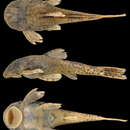Diagnostic Description
provided by Fishbase
This species can be diagnosed from its congeners, except Pareiorhina carrancas, by having a postdorsal ridge (vs. the absence). It can be distinguished from P. carrancas by having a more elevated postdorsal ridge, 6.7-26.8% of CP depth (vs. 4.47-9.03%). It can be further distinguished from P. cepta by having a naked abdomen (vs. having small plates covered with odontodes irregularly distributed on the abdomen); from P. brachyrhyncha and P. cepta by having unicuspid teeth (vs. teeth with a minute lateral cusp); from P. carrancas and P. rudolphi by having the anterior profile of the head rounded in dorsal view (vs. elliptical) and by having a greater suborbital depth (35.0-40.5% of HL vs. 27.4-34.2% in P. carrancas and 24.5-31.8% in P. rudolphi). This species further differs from its congeners by having head width 100.1-108.6% of HL (vs. 91.7-98.1% in P. brachyrhyncha, 82.9-96.2% in P. carrancas, 83.4-90.5% in P. cepta and 77.8-82.1% in P. rudolphi) (Ref. 93835).
Morphology
provided by Fishbase
Dorsal soft rays (total): 9; Analsoft rays: 6; Vertebrae: 29
Trophic Strategy
provided by Fishbase
Found in moderate to fast-flowing streams, with a substrate of rocks and sand and margins covered by aquatic vegetation. Occurs in association with loose stones, on the streambed. Syntopic throughout its distributional range with Astyanax sp., Characidium sp., Geophagus brasiliensis, Harttia cf. carvalhoi, Imparfinis sp., Neoplecostomus microps, Trichomycterus cf. alternatus, and Trichomycterus sp. (Ref. 93835).
Biology
provided by Fishbase
Found in moderate to fast-flowing streams, with a substrate of rocks and sand and margins covered by aquatic vegetation. Occurs in association with loose stones, on the streambed. Syntopic throughout its distributional range with Astyanax sp., Characidium sp., Geophagus brasiliensis, Harttia cf. carvalhoi, Imparfinis sp., Neoplecostomus microps, Trichomycterus cf. alternatus, and Trichomycterus sp. (Ref. 93835).

